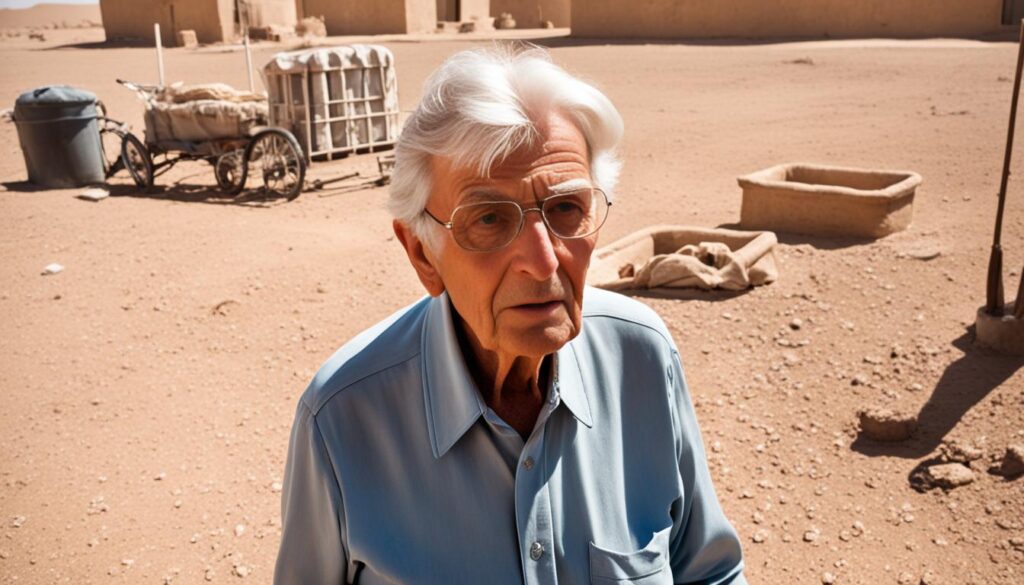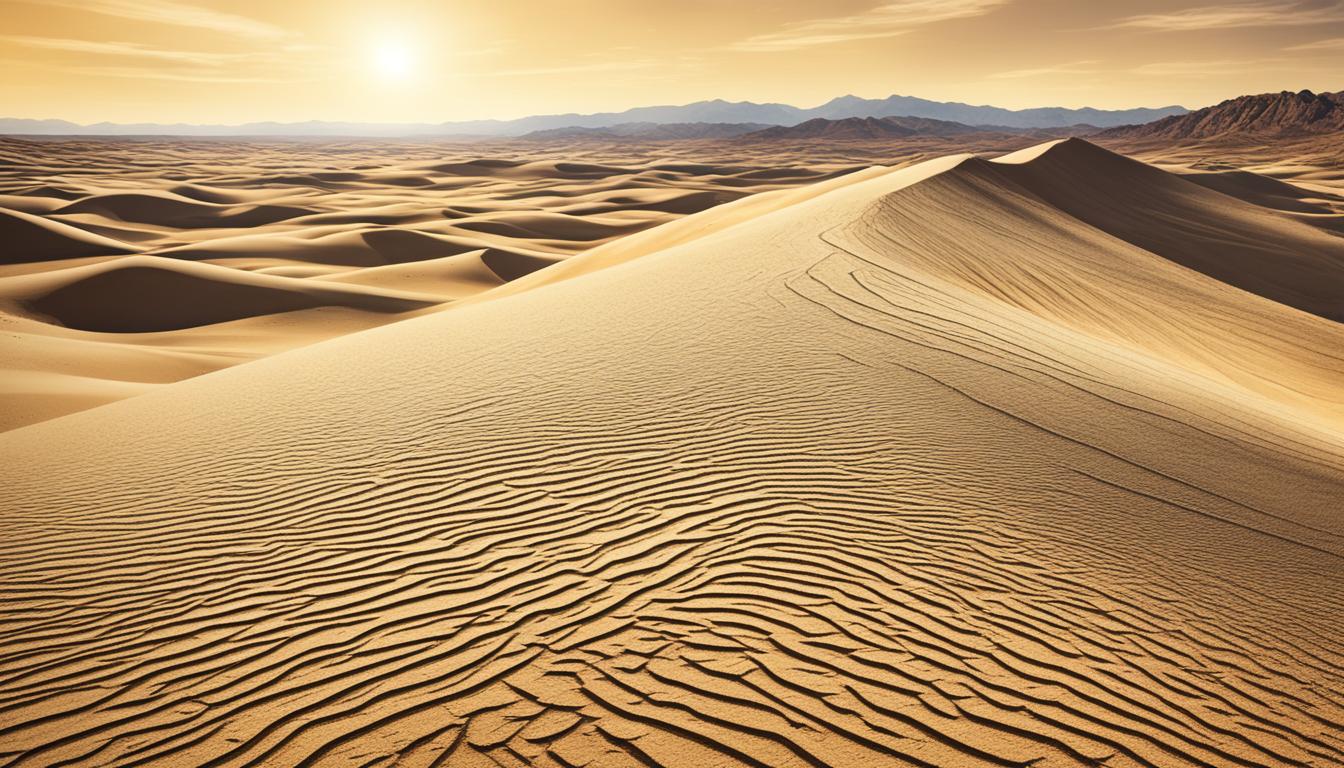Desert sand and sandstorms are common events that pose serious health risks worldwide1. About 25% of dust comes from human actions like cutting down trees, harming the land, and changing the climate1. Around 330 million people face dust every day, carried by winds from far away1. Climate change makes deserts grow, which could make sand and dust storms worse1.
The WHO Eastern Mediterranean Region and other places see more sand and dust storms now1. These storms last longer and are more intense1.
Most studies looked at how dust affects health over time2. Almost all found links between dust and health problems, like breathing and heart issues2. But, different ways of measuring dust and health effects led to mixed results2. Creating a common way to study this could help us understand the link better.
Key Takeaways
- Desert sand and sandstorms pose significant risks to human health and the environment worldwide.
- Human activities account for approximately 25% of dust emissions, contributing to the increasing frequency and intensity of sand and dust storms.
- Exposure to wind-transported desert dust particles affects over 330 million people globally.
- More than half of the studies on the health impacts of desert dust use time-series study designs, but methodological inconsistencies exist.
- Developing standardized research protocols is crucial to better understand the association between desert dust and adverse health effects.
What are Sand and Dust Storms?
Sand and dust storms happen when strong winds pick up large amounts of sand and dust from dry, bare soil3. These particles can travel long distances, impacting areas far from where they started4.
Causes and Sources of Sand and Dust Storms
The main places for sand and dust storms are dry and semi-dry areas around the world4. These include Northern Africa, the Arabian Peninsula, Central Asia, and parts of China4. Human actions like cutting down trees, overgrazing, and wasting water make these storms worse35.
Climate change is making these storms more likely by causing more droughts and extreme heat5. The Earth’s temperature has gone up by 1.1°C since before industrial times, making it easier for these storms to happen and get worse5.
| Key Facts about Sand and Dust Storms |
|---|
|
The United Nations sees the need to fight sand and dust storms, marking July 12th as the International Day of Combating Sand and Dust Storms5. Working together globally and regionally is key to tackling these environmental issues5.
Increasing Frequency and Intensity
Sand and dust storms are happening more often and are getting worse. They threaten our environment, climate, and health. In the 20th century, desert dust doubled in some areas, making these storms more powerful6. Climate change and poor land management are causing more storms by taking away vegetation and leading to desertification6.
The United Nations made July 12 the International Day of Combating Sand and Dust Storms. This day aims to raise awareness and encourage global action against these storms6. The world loses nearly 1 million square kilometers of healthy land each year, which is as big as five Central Asian countries6.
These storms affect many areas, with the Sahara Desert being the main source of dust in the air7. Dust from the Sahara reaches the Caribbean more often in spring, summer, and early fall. Studies show more dust is moving to the western Mediterranean since 19487.
Dust storms cause big problems, like affecting air travel, supply chains, crops, and infrastructure. They can also spread diseases8. In the Middle East and North Africa, dust storms cost $13 billion in GDP each year. The World Health Organization says 7 million deaths happen every year due to bad air quality, including from sand and dust storms8.
We need a global effort to fight desertification, grow vegetation, and create early warning systems for these storms6. The situation is serious, but with the right plans and working together, we can lessen the impact of sand and dust storms6.
desert sand, transported by the wind, affects climate, environment, human health
Desert sand, carried by the wind, impacts our climate, environment, and health9. In the past ten years, studies on desert dust have grown a lot9. This dust carries pollen, fungi, bacteria, viruses, and more9.
Impact on Air Quality and Climate
The Sahara desert sends over 50% of global dust into the air, followed by Asia and the Middle East9. This dust can reach places as far as North America and Europe910. Every year, the Atlantic gets a lot of Saharan dust, affecting the Caribbean and South America10.
This dust can stop thunderstorms and make the day hotter by keeping the sky dry10. It also makes the air dirty, which is bad for people with breathing problems10.
Some people are more at risk from the dust, like babies and older adults10. It can also kill plants by covering them and stopping them from making food through photosynthesis10.
But, the dust can also be good for plants and forests by adding nutrients10. It helps phytoplankton and marine life, which is good for the ocean10.
Yet, the dust can also cause harmful algae blooms in the ocean10. It can also make coral bleaching worse, which is bad for coral reefs10.
In Australia, a big dust storm in 2009 cost nearly $300 million11. Wind erosion happens when there’s not enough plants to stop the wind, and drought makes it worse11.
Groups like DustWatch in Australia work to track wind erosion and teach people about dust problems11. They want to help manage the land better11.
Health Effects of Sand and Dust Storms
Sand and dust storms are harmful to our health, affecting our lungs and hearts12. Large dust particles can hurt our skin, eyes, and ears12. Smaller particles can get into our lungs and cause breathing problems12. They can even affect our blood, immune system, and brain12.
Research shows that sand and dust storms are dangerous13. They led to more deaths in the U.S. from 1993 to 200513. In El Paso, Texas, these storms caused more people to go to the hospital for asthma and bronchitis13. In Sydney, Australia, they were linked to more deaths from air pollution from 1994 to 200713.
These storms are bad for our lungs, especially with climate change making them worse13. Dust storms can cause inflammation and other health issues in young people13. They also lead to more heart and lung diseases in areas where they happen often13.
But it’s not just our lungs at risk. Sand and dust storms can cause more deaths from heart and lung problems in Kuwait13. In China, babies exposed to these storms before birth had lower brain function, showing how dangerous they are for kids13.
To fight the health risks of these storms, we need to know what’s in them and protect ourselves12. We should work together to find solutions and spread the word about the dangers12.

Practices recommended for tackling polluted dust storms include identifying particle content for each storm, archiving samples from each desert dust storm, protecting indoor and closed spaces from submicron particles, and educating biomedical and meteorological experts jointly.
Identifying and Quantifying Desert Dust Exposure
It’s key to measure desert dust exposure to understand health risks. Studies use different methods to check dust levels, with some focusing on yes or no answers14. Others try to measure how much dust people breathe in.
Methods and Challenges in Exposure Assessment
Creating a standard way to measure dust would help us understand its health effects better. This is crucial because different studies use different ways to measure dust14.
Measuring dust is hard because dust can be complex and its levels change a lot. Weather and pollution can also make it hard to know how dust affects health14.
| Location | Dust Exposure Metrics | Concentration Levels |
|---|---|---|
| Northeastern Arabian Gulf | Atmospheric deposition fluxes of 137Cs | 565 to 572 Bq/m^2 |
| Eastern Mediterranean | Ambient dust under climate change conditions | 1352 to 1360 μg/m^3 |
| Canary Islands | TSP and PM2.5 during a dust episode | 4715 to 4728 μg/m^3 |
| Europe | Elemental composition and concentrations of PM10 | 6107 to 6129 μg/m^3 |
| Italy | Contribution of desert dust to PM10 loads | Variable |
| NW Mediterranean | Seasonal variability of elemental composition of atmospheric aerosol particles | 353 to 361 μg/m^3 |
This table shows the different ways to measure dust exposure and the levels found in various places14. Understanding these patterns is key to knowing how dust affects health and making health plans.
As desert dust storms get more common, we need better ways to measure dust exposure. Researchers and health experts must work together to create standard methods for all regions and people15.
“Accurately measuring and quantifying desert dust exposure is crucial for understanding the potential health impacts.”
Susceptible Populations and Affected Areas
Every day, about 330 million people breathe in particles carried by wind from far away16. These particles can travel thousands of kilometers from where they come from16. The effects on health can be different near the source of the dust and far away, where the dust mixes with other pollutants16.
Sand and dust storms happen often in dry places like deserts and semi-deserts17. Areas like the Arabian Peninsula, eastern Mediterranean, Lower Mesopotamia, and northeast Asia see more wind erosion and dust storms17. These storms can last from hours to days, sometimes making the air very dusty17.
The Taklimakan desert is huge, covering 337,000 km²16. In Moyu County, there are over 220 dusty days a year, with 60 days of big sand storms16. Dust storms are most common from April to August, especially in May and June16.
| Location | Annual Average Temperature | Annual Average Precipitation | Annual Evaporation | Frost-free Period | Annual Sunshine Time |
|---|---|---|---|---|---|
| Moyu County | 11.3 °C (-18.7 °C to 26.4 °C) | 36-37 mm | 2239 mm | 177 days | 2655 hours |
Older people and those under 15 are more affected by dust storms16. A study looked at 1,200 people’s health during dust storms in Moyu County16.

Epidemiological Study Designs
Epidemiological studies are key to understanding how desert sand and dust storms affect health. More than half of the studies (52.9%) used a time-series study design to look at the health effects of desert dust and sandstorms.18 These studies show how short-term exposure to desert dust can lead to health issues like breathing problems, heart issues, and problems during pregnancy.
But, these studies have some big limitations. They struggle with measuring exposure and analyzing data, which can lead to unclear results on how desert dust affects health18. To fix this, researchers use different study designs like case-crossover, longitudinal, cohort, and case-control studies.
Time-Series and Other Study Designs
A study in the Sahel region found that desert dust reduced warm days, nights, and tropical nights during certain times.18 Research on the 1930s Great Plains drought showed that being exposed to drought didn’t shorten the life of older men.18 These studies show how different approaches help us understand the link between desert dust, climate, and health.
In California, severe drought, heat waves, and dust events from 2003 to 2020 led to higher temperatures, less soil moisture, and less vegetation, along with more dust.18 A study in Northern Khuzestan, Iran, found that more dust meant a higher stroke risk for men, and high wind and humidity also increased stroke risk in some groups.18 These findings stress the need to study how environmental factors affect health.
Research on desert dust and sandstorms is growing, with scientists using various designs to learn more about how environmental exposures affect health.
| Study Design | Description | Advantages | Limitations |
|---|---|---|---|
| Time-series | Looks at how desert dust exposure over time affects health. | Good for finding immediate health effects, can study a large group. | May have confounding factors, hard to prove cause and effect. |
| Case-crossover | Compares an individual’s exposure during a health event to another time. | Controls for personal factors, great for studying sudden health effects. | Needs accurate exposure data at specific times. |
| Longitudinal | Follows people over time to see the long-term health effects of desert dust. | Can look at total exposure and ongoing health effects. | May lose participants, takes a lot of time and resources. |
| Cohort | Compares health outcomes in a group exposed to dust and a non-exposed group. | Shows when exposure happened before health issues, good for rare outcomes. | Challenges in measuring exposure, may need a big sample size. |
| Case-control | Looks back at exposure history of people with and without a health issue. | Efficient for rare outcomes, can look at many exposures. | Prone to recall bias, hard to pick good control groups. |
Research on desert dust and sandstorms is ongoing, with scientists using various designs to understand how environmental exposures affect health.
“Understanding the health impacts of desert dust requires a multifaceted approach, combining different epidemiological study designs to paint a comprehensive picture.”
Mitigating Strategies and International Efforts
Dealing with sand and dust storms needs a mix of actions. States can act early to lessen their effects and get stronger. A key move is land restoration. This means making better use of water, protecting soil, and planting native plants19. These steps help keep more water in the land, cut down on sand and dust, and support farming in dry areas19.
Also, cutting down on emissions is key to fight desertification and more frequent dust storms19. Groups like the Food and Agriculture Organization (FAO) are leading the way19. They’re pushing for more action and money to fight against sand and dust storms19. The FAO works on making countries better prepared for these storms, doing risk checks, and planning for emergencies19.
Land Restoration and Emission Reduction Efforts
The FAO is starting tree planting projects to lessen the effects of sand and dust storms19. In places like Lebanon, the “Smart Adaptation of Forest Landscapes in Mountain Areas” (SALMA) project has planted trees and made plans to protect more land19. This work helps make local communities stronger and safer19.
Other countries are also fighting sand and dust storms. For example, Saudi Arabia plans to plant 50 billion trees, which is the biggest tree-planting effort ever20. The United Arab Emirates is also using new technology to predict dust storms better20. These actions show how important it is to tackle sand and dust storms with new strategies1920.
“SDS events lead to substantial economic losses in the MENA region, affecting infrastructure, agriculture, and health-related costs due to air pollution, resulting in billions of dollars in GDP losses annually.”19
Even with progress, there are still big challenges. In places like Iraq, finding money and resources for green projects is hard20. But, working together and investing in land restoration and emission reduction is key to fighting the effects of sand and dust storms1920.
Early Warning Systems and Public Health Response
States are fighting against sand and dust storms by investing in early warning systems. These systems alert people when storms are coming21. This can save lives and reduce economic losses. In 2007, the World Meteorological Organization started the SDS-WAS to help countries get ready for these storms21.
The SDS Compendium offers tools and advice for monitoring and predicting storms21. It also helps with early warnings, reducing damage, and making communities more resilient21. The UNCCD launched a new toolbox to help countries prevent and manage sand and dust storms21.
The health sector needs to improve its knowledge and response to desert dust’s health effects21. It should work more closely with government agencies for a quick and effective health response21. The WMO works with UN partners like the World Health Organization and the UN Environment Programme to tackle sand and dust storms21.
Central Asia is very vulnerable to dust from the Aral Sea basin, with over 80% of its land being deserts and steppes21. The EU’s Copernicus Atmosphere Monitoring Service predicts that PM10 levels will often exceed the EU’s safety limit in affected areas21. Dust from the Sahara is also moving across the Atlantic Ocean, reaching the Caribbean, and is expected to keep doing so21.
By investing in early warning systems and improving public health responses, communities can better handle the effects of these storms21.
Research Gaps and Future Directions
Significant progress has been made in understanding desert sand and dust storms. Yet, there are still important research gaps to fill. These gaps affect public health and the environment22. One key issue is the need for standard ways to measure the long-term health effects of desert dust22.
Working together across countries is crucial. This will help us understand the long-term health effects and find out who is most at risk22.
Long-term Health Effects and Harmonized Protocols
Studies have shown the immediate health risks of sand and dust storms. But, we need more research on the long-term effects22. Long-term studies and standard ways to measure exposure are key. They will help us understand the full impact of desert dust on health23.
This work will help make better health policies and interventions. It will also guide us on how to reduce the risks over time.
Scientists must work on making standard ways to measure desert dust exposure23. This will make it easier to compare studies and understand the health risks better. It will also help in making effective strategies to reduce these risks.
| Key Research Areas | Potential Impact |
|---|---|
| Long-term health effects of desert dust exposure | Quantify the true burden on public health and guide targeted interventions |
| Harmonized exposure assessment protocols | Enable more accurate comparisons and comprehensive understanding of risks |
| Collaborative, multi-country research | Develop a global perspective and address the diversity of dust-affected regions |
By tackling these research gaps and working together, scientists can help make better policies. These policies will reduce the health and environmental impacts of desert storms2223.
Conclusion
Sand and dust storms are a big worry for the environment and public health, hitting23 77% of all countries worldwide23. These storms are most common in dry areas of Central Asia because of low rainfall, high heat, and strong winds24. The large areas of sandy, clayey, and salty deserts make these storms worse24.
Even though we know a lot about how desert dust and sandstorms affect health, there are still some issues with the studies. We need better ways to measure exposure and analyze the data23. Creating standard research methods is key to understanding how desert dust affects people’s health23. We also need to tackle the main causes of desertification, like climate change and poor plant growth24. Improving early warnings and working together across borders are also important steps24.
The world is facing big challenges from sand and dust storms. It’s vital to focus on conclusion research, policy, and working together across borders. By tackling the main issues and coming up with good solutions, we can keep communities safe and healthy worldwide.
FAQ
What are sand and dust storms?
What are the causes and sources of sand and dust storms?
How has the frequency and intensity of sand and dust storms changed over time?
How do sand and dust storms affect climate, the environment, and air quality?
What are the health effects of sand and dust storms?
How do researchers identify and quantify desert dust exposure?
Which populations are most susceptible to the effects of sand and dust storms?
What types of epidemiological study designs have been used to investigate the health effects of sand and dust storms?
How can sand and dust storms be mitigated?
What are the current efforts to address the health impacts of sand and dust storms?
What are the research gaps and future directions in understanding the health effects of sand and dust storms?
Source Links
- Sand and dust storms
- Effects of Desert Dust and Sandstorms on Human Health: A Scoping Review
- As climate changes, sand storms wreak havoc on desert communities
- Desert dust storms carry human-made toxic pollutants, and the health risk extends indoors
- International Day of Combating Sand and Dust Storms | United Nations
- Sand and dust storm frequency increasing in many world regions, UN warns
- What is desert dust and how does it change atmosphere and the air we breathe?
- More action needed on sand and dust storms
- A Systematic Review of Global Desert Dust and Associated Human Health Effects
- What to know about Saharan dust affecting the US and how it can affect health
- Wind erosion
- Desert dust storms carry human-made toxic pollutants, and the health risk extends indoors
- Global Health Impacts of Dust Storms: A Systematic Review
- Monitoring the impact of desert dust outbreaks for air quality for health studies
- On the Association between Fine Dust Concentrations from Sand Dunes and Environmental Factors in the Taklimakan Desert
- Health Effects of Dust Storms on the South Edge of the Taklimakan Desert, China: A Survey-Based Approach
- Sand and Dust Storms: Impact Mitigation
- Sand and Dust Archives – ClimaHealth
- Combating sand and dust storms in MENA: the role of tree plantation
- Sand and Dust Storms in the MENA Region: A Problem Awaiting Mitigation
- WMO highlights efforts to tackle sand and dust storms
- Desert dust hazards: A global review
- Causes and Effects of Sand and Dust Storms: What Has Past Research Taught Us? A Survey
- Conclusions

